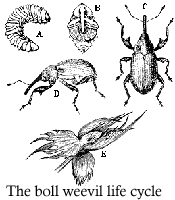|









|
Back to Back Roundup Ready Threatens Boll Weevil Control  (5 April - Cropchoice News) -- South Carolina farmers who follow Roundup Ready cotton with Roundup Ready soybeans may accidentally provide a refuge for boll weevils, says Clemson University entomologist Mitchell Roof. (5 April - Cropchoice News) -- South Carolina farmers who follow Roundup Ready cotton with Roundup Ready soybeans may accidentally provide a refuge for boll weevils, says Clemson University entomologist Mitchell Roof.
The problem is volunteer Roundup Ready cotton that grows in with Roundup Ready soybeans. Since bean fields aren't usually scouted for weevils, Roof says what "could have been a million dollar mistake" was narrowly averted last year. In Orangeburg County (SC) boll weevil containment program staff caught a rapidly-growing weevil population in volunteer cotton that had sprung up in 12 Roundup Ready soybean fields. The weevils threatened nearby cotton fields. The last time there was a weevil reinfestation in South Carolina, it cost farmers $1.3 million to get rid of the bugs.
Solutions could be costly. South Carolina farmers already pay $5-$6 /acre for the boll weevil containment program. But that might increase in South Carolina and elsewhere if the bug catchers have to expand their monitoring and scouting because of Roundup Ready crops.
If outbreaks do occur, chemical controls and/or traps are required. Interviewed by Farm Press, North Carolina State University Weed Specialist Alan York says there's a management solution - either through additional tilling to encourage seed rot, burndown spraying, or by mixing additional herbicides in with early season Roundup applications.
Canadian canola famers up north in Manitoba and Saskatchewan might sympathize with South Carolina cotton and soybean growers. There too, unanticipated consequences of GMO crops have led to recommendations from the experts for additional, expensive trips across the field and spraying. In Canada's west, the problem is with outcrossed volunteer canola - in some cases resistant to Roundup, Liberty, and Pursuit. Canadian experts have said farmers should buy and spray 2,4-D on such plants.
According to Roof, about 90% of South Carolina farmers use glyphosate-resistant cotton varieties. The percentage is especially high in the state because of its weed profile. Entomologists are scrambling to keep up with the problem - now instead of just tracking cotton fields, they'll have to worry more about varieties and acreage that rotated into non-cotton Roundup Ready crops. Other states where Roundup Ready cotton and soybeans mix are also potentially susceptible to the problem.
Through containment programs, boll weevils have been severely reduced as major economic pests in Arizona, California, the Carolinas, Florida, Georgia, and Virginia. Programs are working or will be started soon in Arkansas, Louisiana, Mississippi, Missouri, Tennessee and Texas.
But the back to back Roundup Ready problem is aggravating a tough job. According to Roof, "all it would take to produce a reinfestation in these circumstances, is to add one female boll weevil capable of laying fertilized eggs. These often get in by hitching rides on transport vehicles or even used farm equipment... as long as we have boll weevils somewhere in the US, we will need a Containment program."
SOURCE: M. Roof - Clemson University, Monsanto Editors, Farm Press News.
|



